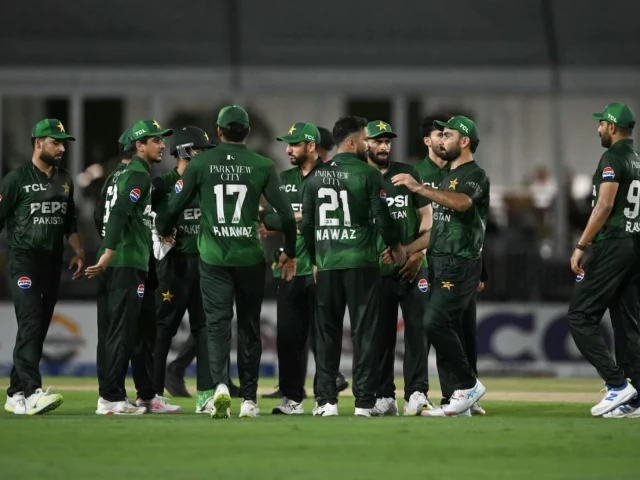
YOUNG SIDE: The Pakistan team was celebrating their victory against West Indies in the T20I series. Photo: AFP/File
KARACHI:
The announcement of Pakistan’s squad for the upcoming UAE T20 Tri-Series and the much-anticipated Asia Cup 2025 has sparked intense conversations across the cricketing world. The omission of experienced duo like Babar Azam and Mohammad Rizwan from the 17-member squad is not just a headline—it marks a shift in Pakistan’s T20 philosophy.
Yet, as the dust settles, one truth emerges: Pakistan’s young guns have both the talent and temperament to seize the moment and fill the void left by two of the country’s most consistent performers.
Pakistan’s white-ball head coach Mike Hesson was quick to underline the thought process behind the selection. On social media, he described the squad as “a great blend of energy and experience,” highlighting the balance between established performers and fresh talent.
With names like Shaheen Shah Afridi and Haris Rauf providing stability and firepower in the bowling department, and rising stars like Saim Ayub, Sahibzada Farhan, and Hasan Nawaz bringing aggression to the batting order, Pakistan have deliberately chosen a squad built for the demands of modern-day T20 cricket.
Young brigade steps in
At the heart of this transition are players who represent Pakistan’s future.
Saim Ayub has already shown flashes of brilliance with his bold stroke play and fearless approach, while Sahibzada Farhan has made a strong case for himself with three Player-of-the-Match awards in just six T20Is.
Fakhar Zaman, though not entirely new, continues to offer the kind of explosive batting that can change games within a few overs.
Add Mohammad Haris’s natural attacking flair with the bat and skills behind the stumps, and Pakistan suddenly look like a side ready to match, if not surpass, the strike rates that Babar and Rizwan were often criticised for.
This new approach aligns with the global evolution of T20 cricket. Powerplay overs are no longer about consolidating; they are about striking hard and fast. Pakistan’s decision to opt for aggressive openers reflects a broader recognition of what it takes to win at the highest level. In this sense, the likes of Saim and Farhan are not just replacements—they are the embodiment of a new mindset.
Confidence Hesson
Hesson’s emphasis on bowling variety is equally crucial.
With five frontline seamers and two mystery spinners, Pakistan’s attack is tailor-made for UAE conditions, where adapting quickly is often the difference between victory and defeat.
He also stressed that this squad represents “a much-improved fielding side,” another area where Pakistan have historically lagged but now seem determined to catch up.
If the bowlers can complement the batting firepower with discipline and sharpness in the field, Pakistan will enter the Asia Cup as genuine contenders.
Aqib’s assurance
Selector and former pacer Aqib Javed also brought clarity to the debate surrounding Babar and Rizwan.
He reminded fans and critics alike that exclusions in cricket are rarely permanent.
“Whoever performs will play,” he said, stressing that opportunities in the national side depend on consistency and form, not past reputation.
For Babar and Rizwan, both of whom are still competing in international leagues, the message is clear: performance will dictate their return.
This perspective is vital for Pakistan cricket. It ensures accountability and avoids the pitfalls of over-reliance on individuals.
It also motivates the younger players, who now know that strong performances will not go unnoticed.
Sahibzada Farhan’s resurgence, Saim’s learning curve, and Fakhar’s adaptability are examples of how patience and faith in talent can pay off.
The road ahead
Pakistan’s group in the Asia Cup—featuring arch-rivals India alongside Oman and UAE—offers the perfect stage for this new-look side to test its mettle.
The Pakistan-India clash on September 14 in Dubai will be the ultimate litmus test, not only for the youngsters stepping into the spotlight but also for the selectors’ bold strategy.
If they succeed, Pakistan may have found a new formula to rival India’s explosive top order.
Transitions are rarely smooth in cricket, especially when they involve moving on from iconic figures like Babar and Rizwan.
But every era demands its heroes, and this squad is brimming with candidates ready to answer that call.
The Asia Cup 2025 might just be remembered not as the tournament where Babar and Rizwan were absent, but as the stage where Pakistan’s next generation announced itself to the world.
